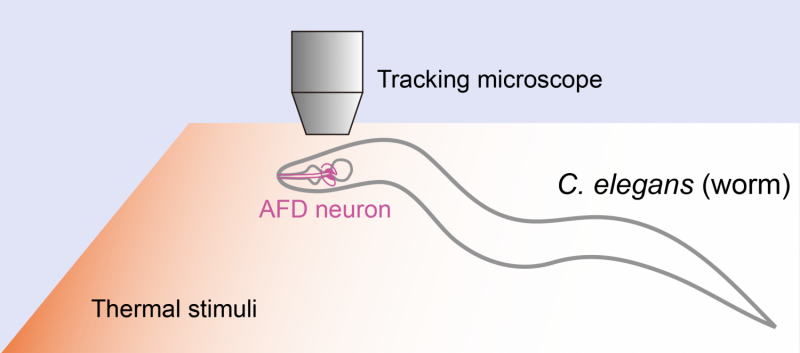Watching worms (C. elegans) . A tracking microscope was used to study both the movement and AFD neuron response of C. elegans to thermal stimuli.
Nagoya University researchers reveal how perceived external information is converted into a succession of neural activities that are crucial for appropriate navigation in an environment
When the surrounding environment makes us uncomfortable, we are inclined to move to a more agreeable one.
Studies have shown that animals do the same. They organize sequences of movements to migrate to preferred environments. Understanding how environmental information is converted to sensory information in the brain is vital for a deeper understanding of animal behavior and human perception. However, not much is known about this process.
The movement of Caenorhabditis elegans—or roundworm—in response to temperature changes has been extensively studied. Deletion of a pair of sensory neurons, known as AFD, severely hindered the worms' ability to react to an increase or decrease in temperature, indicating that AFD plays a crucial role in such responses.
Based on this knowledge, researchers from Nagoya University set out to investigate exactly how AFD converts the sequences of sensory inputs that are triggered by changing temperatures into neural activity.
"We used simultaneous calcium imaging and a tracking microscope for freely moving animals to characterize thermal response in C. elegans," first author of the study, Yuki Tsukada, explains. "The worms were raised in different temperatures, but were all subjected to the same temperature range of between 17°C and 23°C during the test."
The researchers found that the responses in the worms were similar regardless of the conditions they were raised in. Interestingly, the adaptation and detection of an input signal was around 20 seconds, a timescale comparable to that of behavioral movements, such as turning. Using a mathematical model, the researchers were able to reconstruct the AFD activity from the observed temperature input and, conversely, the thermal environment from the observed AFD activity and the migration pattern of the worms. This verifies that the thermotaxis of C. elegans is an appropriate model for exploring the relationship between the environment and the response of the organism.
"This modeling approach with the simple nervous system of C. elegans may allow us to conduct behavioral studies at different scales, from single cell organisms like bacteria to mammals," senior author of the study, Ikue Mori, says. "Such studies are extremely valuable in helping to understand the basis for animal behavior, including that of humans, in an ever-changing environment."
More information: Y. Tsukada et al. Reconstruction of Spatial Thermal Gradient Encoded in Thermosensory Neuron AFD in Caenorhabditis elegans, Journal of Neuroscience (2016). DOI: 10.1523/JNEUROSCI.2837-15.2016
Journal information: Journal of Neuroscience
Provided by Nagoya University























